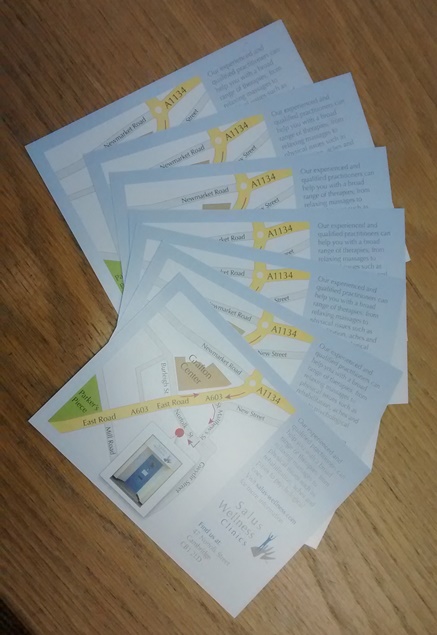
 In a world where social media has literally transformed the way we (should) market our businesses we can still find many businesses who embark in traditional marketing exercises; good news is that some of them, if well executed, still work. This post will briefly discuss leafleting, a form of advertising and promotion which can be used effectively for certain complementary health practices.
In a world where social media has literally transformed the way we (should) market our businesses we can still find many businesses who embark in traditional marketing exercises; good news is that some of them, if well executed, still work. This post will briefly discuss leafleting, a form of advertising and promotion which can be used effectively for certain complementary health practices.
By leafleting I mean the design, print and distribution of leaflets into households within a specified geographic area. Leafleting is particularly effective for a local business interested in reaching out to a well defined local community. We are here considering an indiscriminate dropping to all household in a particular area rather than posting to a mailing list which will be discussed in a different post.
Leafleting can work well if you can assume that at least one person in each house can be interested in what you are offering: e.g. massage and other wellbeing treatments can lead to successful campaigns. Hypnotherapy for weight loss and smoking cessation can also work well; very niche treatments for phobias, on the other hand, might not apply to enough people.
There are three essential functions for a leafleting campaign:
- Announcing something: opening of a new business, changing of management for an existing business, arrival of a new therapist and so on;
- Running a promotion: money off your next treatment, get three treatments for the price of two and so on;
- Raise awareness and branding: let people know you exist and they might decide to contact you or buying from you when they have the opportunity.
Each of the above function will have an impact on the message that the leaflet will have to deliver. In order to maximise the possible return on investment here are the main tips about a creating a successful leafleting campaign. They are the results of many campaigns run by our clinic directly as well as on behalf of our practitioners:
- Decide very accurately the function for the leaflet from the list above and execute on one function only.
- Adopt a format which is compact and efficient: A6 (kind of post card), A5 or 1/3 of A4
- Have a professional design which uses your colours (from your logo and company image) and your typefaces.
- Have a message which is captivating and with a clear call to action: e.g. “call our office” or “Email us” or “go to this website and register”.
- If you are running a promotion make sure to have a time limit to instil urgency.
- Have the leaflets printed professionally on good quality paper; first impression does matter.
- Deliver a minimum of 3000 leaflets per run and run at least 3 deliveries in the same area; there a number of options to deliver the leaflets: you can do it yourself and do some exercise or contact a reliable company which will do it for you. It is essential you have very clear where you want them distributed and have a way to check and measure that they effectively delivered.
- Measure results and success of your campaign: in general between 3 and 5 inquiries per 1000 leaflets dropped are considered a successful campaign; anything above that is outstanding. Inquiries will likely arrive within very few days from delivery although sometimes people will save it for later.
Leaflets have a very short life, usually the time from the front door where they fall to the closest bin. When I initially considered them as a marketing tool it came natural to me thinking that they have little chance to deliver their message and they are a waste of paper and they do pollute indeed. On the other hand a successful campaign which delivers 10,000 leaflets and converts to just 30 clients will generate, if you charge £40 per session, £1,200 of immediate new business with 5-10 of these new clients that might come back more than once. By budgeting £300-400 for a batch of 10,000 leaflets you can make a net profit of around £800 per campaign with the advantage of reaching out to clients you would not connect to otherwise.
